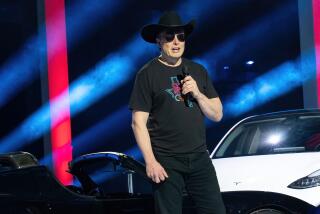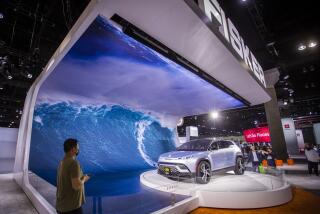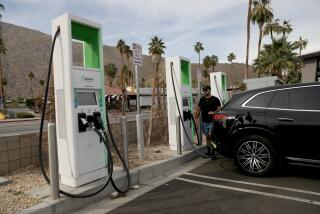BMW Mini E: A rumble in the electric-car jungle
In his Santa Monica gallery, Samuel Freeman displays a nifty bit of automotive art, a full-size replica of a Chevy V-8 engine made out of stained glass. But Freeman himself worships at the church of the electric car.
In November, Freeman was one of nearly 2,000 people who signed up to lease a Mini E -- an experimental electric-vehicle conversion of BMW’s charming, capering retro-runabout. In early June, he was one of the lucky 450 Americans to get a car -- his is No. 104 -- and since then he’s been ripping up the streets of Venice and Santa Monica, quietly.
“The acceleration is huge,” says Freeman, 34, as he mats the accelerator. “It’s got a tremendously lightweight feel.”
“It’s all the G-force of a sports car without the guilt,” he says. “I love it.”
But not everyone in the EV community is so enthused. For the last several months, a not-entirely-civil war of words has erupted on blogs and Facebook between BMW and those who’d volunteered to pay $850 a month for the privilege of leasing a Mini E for a year. Critics say the cars were months late in reaching customers. A shortage of high-power cables left many dealing with desperately slow recharging times. Some of what BMW calls its Mini E “pioneers” have dropped out of the program because of delays in the installation of home charging equipment, others because of the expense of upgrading their home’s electrical service.
Late last month, the grass-roots EV advocacy group Plug In America, based in Santa Monica, denounced the Mini E program as “botched.” BMW’s muddled rollout of the Mini E “makes the whole technology look like it’s not ready for prime time,” says Chelsea Sexton, a member of the group’s advisory board.
The accusation with the most sting is that BMW is exploiting a loophole in the California Air Resources Board’s Zero Emission Vehicle mandate. Automakers who sell more than 60,000 units a year in California must offer a certain number of high-efficiency vehicles to the public. However, because the rules don’t distinguish between selling and leasing vehicles, BMW is getting full credit for vehicles that will be on the road for only a year. (The hydrogen-powered Honda Clarity also benefits from the rules.)
For many EV advocates, the issue resurrects the painful memory of GM’s EV1. When GM no longer needed the cars to meet state requirements, the cars were taken from lessees and crushed.
“We’re afraid that it’s going to be the ‘90s all over again,” Sexton says.
Mini spokeswoman Nathalie Bauters says the company made no secret of trying to take advantage of the Zero Emission Vehicle credits ahead of the June 30 deadline. “There was no gaming of the system,” she says.
As for leasing the cars, as opposed to selling them outright, she notes that the cars use experimental lithium-ion batteries. “Lithium is not used in vehicles sold to the public because we’re not there yet.” (The Mini E is only the second car on the road with such batteries, after the Tesla Roadster.)
Rich Steinberg, manager of product strategy for the Mini brand, concedes that “things could have been done better. There’s legitimate criticism out there.” However, he says, “BMW is clearly committed to this technology. We have learned a bloody ton, and we intend to use that learning in the future.”
For instance, Steinberg says, the company underestimated the time and difficulty in coordinating the installation of the home recharging equipment among subcontractors, utilities and municipal inspectors. This is an issue that is certain to confront more homeowners as EVs enter the market.
Another problem: BMW’s original plan was to use a beefy, high-power cable that had been in use in Europe, assuming it would be quickly approved by Underwriters Laboratories.
Unfortunately, UL’s lengthy testing procedures created a major delay. Program managers also learned that all the equipment to recharge the car -- the wall box, cable and connector -- has to be approved separately and as a unit by UL. Meanwhile, electrical inspectors for different municipalities “all have a different read on the rules,” Steinberg says. Some installations were quickly approved while others were turned down flat.
Ed Kim, an aerospace program manager in Irvine, finally received his high-power charging cable June 8 but ran into problems because the unit was not UL approved.
“Then I got angry,” Kim says. “I was ready to get out.”
BMW and the pioneers have also wrangled over who was entitled to the $7,500 federal tax credit for electric cars. However, it appears now that because the lease is only one year, neither BMW nor the lessees will be able to claim the tax credit.
“Some of these [tax] rules are not even written yet,” Steinberg says.
As the online dispute got uglier last month, BMW was accused of dumping the Mini E on municipalities and other agencies, such as the Los Angeles County Sheriff’s Department, in order to have all the cars on the road by June 30. “We directly refute that,” Steinberg says.
The hostilities became so intense that one of the program participants, Jeff U’ren, a former EV1 driver, was told he would not be getting a car. “I am being punished for bad behavior,” he says. BMW declined to comment on U’ren’s situation.
Executives at BMW confess to being a little bewildered by the EV community’s reaction. “We knew going in this was an extremely evangelistic audience,” Steinberg says. “We also made clear that this was a field trial and not everything was going to go smoothly. That’s why we call them pioneers.”
Yet “we honestly feel like we are doing good,” he says.
And BMW has its defenders, including Freeman.
“What they’ve done is legitimately stick their toe out,” Freeman says.
“The cars are on the road. People will see it, talk about it, want to drive it. You can’t do that with press releases and auto shows.”
--






